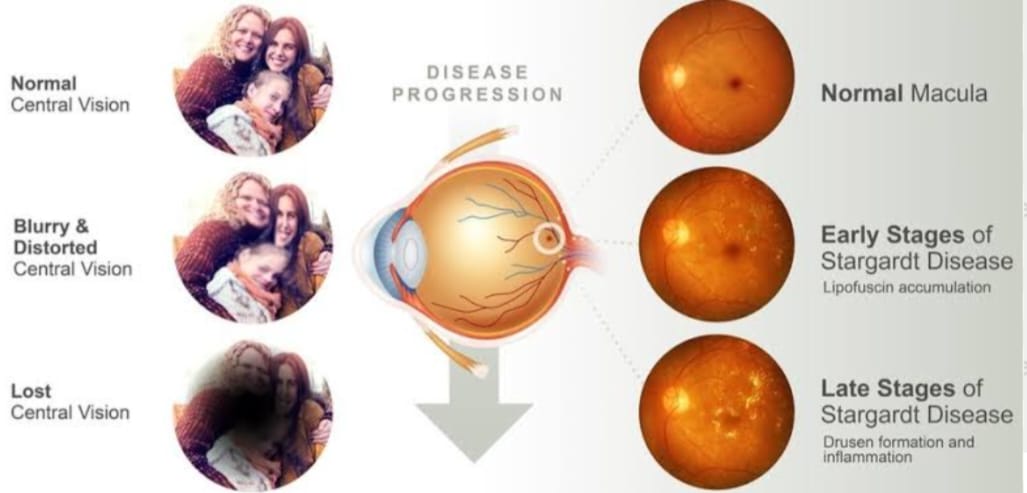Stargardt Disease
Stargardt disease is the most common form of inherited juvenile macular degeneration.Stargardt disease is also called Stargardt macular dystrophy, juvenile macular degeneration, or fundus flavimaculatus.
The disease causes progressive damage or degeneration of the macula. The progressive vision loss is caused by the death of photoreceptor cells in the central portion of the retina called the macula.
The macula is responsible for sharp central vision — for tasks like reading, watching television, and looking at faces.
The retina contains light-sensing cells called photoreceptors. There are two types of photoreceptors: rods and cones. Together, rod and cones detect light and convert it into electrical signals, which are then “seen” by the brain. Rods are found in the outer retina and help us see in dim and dark lighting. Cones are found in the macula and help us see fine visual detail and color. Both cones and rods die away in Stargardt disease, but for unclear reasons, cones are more strongly affected in most cases.
Decreased central vision is a hallmark of Stargardt disease. Side vision is usually preserved.
Stargardt disease typically develops during childhood and adolescence.
Experts estimate that 1 in 8-10 thousand people have Stargardt disease.
Mutations in a gene called ABCA4 are the most common cause of Stargardt disease.
This gene makes a protein that normally clears away “vitamin A” byproducts inside photoreceptors. Cells that lack the ABCA4 protein accumulate clumps of lipofuscin, a fatty substance that forms yellowish flecks. As the clumps of lipofuscin increase in and around the macula, central vision becomes impaired.
Mutations in the ABCA4 gene are also associated with other retinal dystrophies including cone dystrophy, cone-rod dystrophy, and retinitis pigmentosa, a severe form of retinal degeneration.
The most common symptom of Stargardt disease is variable, often slow loss of central vision in both eyes. People with the disease might notice gray, black, or hazy spots in the center of their vision, or that it takes longer than usual for their eyes to adjust when moving from light to dark environments. Their eyes may be more sensitive to bright light. Some people also develop color blindness later in the disease.
The progression of symptoms in Stargardt disease is different for each person. People with an earlier onset of disease tend to have more rapid vision loss. Vision loss may decrease slowly at first, and then worsen rapidly until it levels off. Most people with Stargardt disease will end up with 20/200 vision or worse. People with Stargardt disease may also begin to lose some of their peripheral (side) vision as they get older.
Homeopathic Treatments-:
Homeopathic medicine works out individualization here and treat the person.
Homeopathy treats Stargardt Disease very well by preventing the further damage or degeneration of macula and stops the death of photoreceptor cells.
The Food and Drug Administration (FDA) has approved homeopathic medicine considering as very effective in stargardt disease treatment. The various expression of disease can be managed effectively, gently, and safely with homeopathic medicine.
Homeopathy has reasonably good treatment to offer for Stargardt Disease, which works at two levels:
1. Controls further progress of disease
2. Improves the vision.
Homeopathic medicine is strongly recommended!


